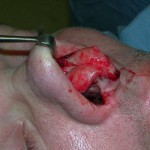In rhinoplasty surgery in the aesthetic patient, there has been an historic debate about an open vs. a closed approach to operating on the bone and cartilage components of the nose. To the patient, however, this is a foreign concept and most have never thought about how their rhinoplasty surgery would be done. While the patient focuses, understandably so, on how the shape of the nose will change, how the plastic surgeon gets there to make these changes is not usually considered.
Historically, rhinoplasty surgery was done through incisions placed inside the nose only. The advantages of a closed rhinoplasty is that there is no scar anywhere on the nose and the amount of swelling of the tip of the nose after rhinoplasty is less. Recent times has seen plastic surgeons shift to an open approach to rhinoplasty to be able to see better and get better and more consistent results. The advantages of an open rhinoplasty is that the plastic surgeon can easily see what changes to the nose are being made, the chance of additonal surgery later on to correct any problems is less, and the scar on the columella (strip of skin between the nostrils) is really insignificant as it heals so well and is fairly ‘hidden’.
I find that patients really have no preference about how their rhinoplasty is done. While the concept of ‘peeling the skin off of their nose’ in an open approach to rhinoplasty is a little unnerving, the patient is most concerned that the rhinoplasty is done as best as possible and the chance of the need for further surgery on their nose is as little as possible. I have yet to have a patient complain about the small scar on their columella and have only ever done one scar revision due to notching. Most of my rhinoplasty surgeries are done open and I reserve the closed rhinoplasty approach for those patients with small concerns about their nose when only limited work is needed mainly in the nasal tip.
Dr Barry Eppley
Indianapolis, Indiana



